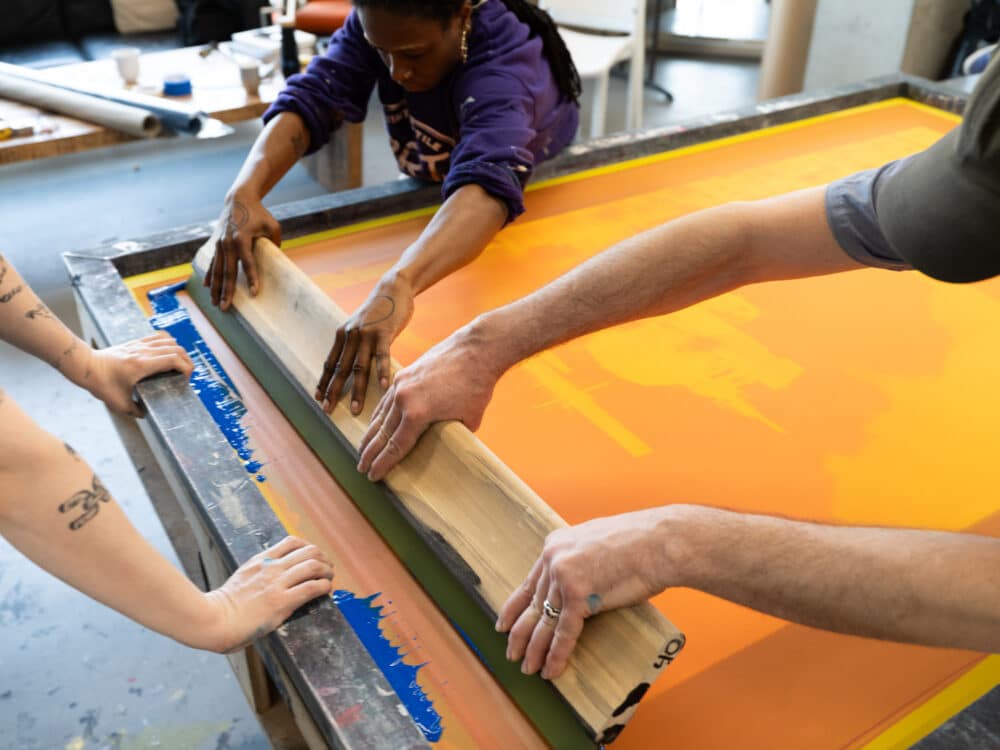The Crucial Overview to Understanding Screen Printing and Its Versatile Uses
Screen printing has an abundant history that dates back to old times, developing into an advanced technique used across various markets today. This overview checks out the complexities of the screen printing procedure, detailing its applications in style, home, and advertising and marketing style - 10:9 Design Abilene. Understanding these fundamentals can open innovative potential for both creative and business tasks. The adhering to areas will certainly disclose crucial pointers and strategies to improve one's screen printing endeavors
The History of Screen Printing
Although screen printing has roots that map back centuries, its advancement mirrors the imaginative and technical improvements of various cultures. Coming from in ancient China, the method was originally utilized for decorating fabrics and later spread to Japan, where it became integral to Ukiyo-e woodblock printing. The approach moved to Europe in the 18th century, where it acquired appeal among artisans and industrial printers. The innovation of image solution in the 20th century reinvented screen printing, enabling more intricate styles and greater performance. Artists like Andy Warhol further pushed its appeal, utilizing the tool to produce legendary works that combined commercialism and art. By the late 20th century, screen printing had developed itself as a flexible strategy, employed in vogue, marketing, and art. Today, it continues to advance, incorporating digital innovation and expanding its applications throughout different sectors.
The Screen Printing Refine Explained
Screen printing transforms imaginative visions right into tangible styles via a series of exact actions. Originally, an image is produced and afterwards moved onto a screen, usually constructed from fine mesh material extended over a structure. A light-sensitive emulsion is used to the screen, which is exposed to light, setting in locations not covered by the picture. After rinsing the unhardened emulsion, a pattern is created.
Next, the screen is positioned over the substratum, whether it be fabric, paper, or another material. Ink is then pressed via the open areas of the stencil utilizing a squeegee, depositing the layout onto the substratum below. This procedure can be repeated for multiple colors, requiring separate displays for each and every tone. Ultimately, the published thing is healed making use of warmth to assure the ink sticks correctly, causing a sturdy, vivid layout all set for usage.
Sorts Of Screen Printing Techniques

Additionally, specialized techniques, such as discharge screen printing, remove dye from the material to produce softer prints, while foil screen printing applies metal aluminum foil to attain a shiny coating (10:9 Design Company). Each strategy uses distinctive characteristics, dealing with numerous imaginative requirements and production scales, ultimately increasing the opportunities within the screen printing domain name
Applications of Screen Printing in Numerous Industries

Additionally, the signage and advertising sectors make use of screen printing for developing attractive display screens and banners. This technique permits bold shades and complex layouts more info that capture focus. In electronic devices, screen printing is utilized for using conductive inks to circuit boards, vital for part links. The home style industry welcomes screen printing to generate distinct designs on textiles and wall surface art. In general, screen printing acts as an important tool throughout diverse fields, improving items with individualized and visually enticing graphics.
Tips for Successful Screen Printing Projects
While taking on a screen printing job, careful interest to detail can considerably boost the final result. Initially, selecting high-grade materials is essential; this includes the screen, inks, and substratums. Using proper mesh matters can influence ink deposition and detail resolution. Preparation is equally essential; detailed cleaning of screens and appropriate direct exposure times ensure crisp prints.
Next off, exact enrollment is vital for multi-color prints. Making use of placement tools can aid accomplish precise layering. Furthermore, screening prints on scrap products before production assists recognize possible concerns without wasting resources.
.png)
Frequently Asked Concerns
What Products Are Best for Screen Printing on Material?
Cotton and polyester blends are optimal for screen printing on material because of their resilience and ink absorption. In addition, specialty fabrics like silk or canvas can generate one-of-a-kind textures and coatings, improving the general layout high quality.
Just how Do I Clean and Maintain Screen Printing Equipment?
To keep and clean screen printing tools, one should routinely clean displays with appropriate solvents, examine mops for wear, oil relocating parts, and store all products in a dry, dust-free environment to extend their life expectancy.
What Are the Ecological Influences of Screen Printing?
Screen printing can have significant environmental effects, including chemical waste from solvents and inks, water use during cleaning procedures, and power usage. Eco-friendly products and lasting practices are necessary for decreasing these adverse effects.
Can Screen Printing Be Done at Home Efficiently?
Screen printing can be successfully done at home with the appropriate products and techniques. Enthusiasts can produce top quality prints, though success relies on their ability degree, devices, and understanding of the procedure entailed.
What Are the Costs Related To Beginning a Display Printing Company?

Starting a screen printing business entails costs for devices, materials, and office. Initial costs normally range from a couple of hundred to a number of thousand dollars, relying on the scale, top quality of machinery, and desired manufacturing capacity.
Screen printing has an abundant history that dates back to old times, developing right into a sophisticated strategy used throughout various markets today. Another strategy, rotary screen printing, employs round displays, facilitating constant printing on fabric rolls, therefore improving performance for large-scale manufacturings. In addition, specialty strategies, such as discharge screen printing, remove dye from the material to create softer prints, while aluminum foil screen printing uses metallic foil to attain a shiny finish. In the fashion market, screen printing is widely utilized to develop lively layouts on apparel, allowing brands to display their one-of-a-kind designs. Cotton and polyester blends are perfect for screen printing on fabric due to their sturdiness and ink absorption.